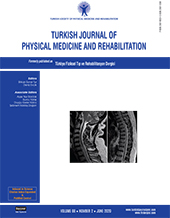Comparison of mobilization with supervised exercise for patients with subacromial impingement syndrome
2 Division of Physical Therapy and Rehabilitation, Istanbul Aydın University, Faculty of Health Sciences, Istanbul, Turkey
3 Division of Physical Therapy and Rehabilitation, Istanbul University, Faculty of Health Sciences, Istanbul, Turkey
4 Department of Physical Medicine and Rehabilitation, Acıbadem University, Faculty of Medicine, Istanbul, Turkey DOI : 10.5606/tftrd.2020.3649 Objectives: This study aims to investigate the effects of joint mobilization with supervised exercise in patients with subacromial impingement syndrome (SAIS).
Patients and methods: This prospective, randomized-controlled study included a total of 40 patients (18 males, 22 females; mean age 43.52 years; range, 27 to 67 years) with SAIS of more than six weeks between June 2014 and June 2015. The patients were randomly allocated into two groups: Group 1 (n=20) received joint mobilization and neuromuscular electrical stimulation and Group 2 (n=20) received a supervised exercise program and neuromuscular electrical stimulation. The outcome measures included the range of motion, pain intensity, the Disabilities of the Arm, Shoulder and Hand (DASH) questionnaire, American Shoulder and Elbow Surgeons Standardized Shoulder Assessment Form-patient self-report section, Short Form-36, and Global Rating of Change Questionnaire. Pain was evaluated using the visual analog scale (VAS).
Results: In both groups, the mean VAS scores significantly decreased and the range of motion significantly increased after treatment (p<0.05). Both joint mobilization and supervised exercise combined with neuromuscular electrical stimulation led to a significant improvement in function in patients with SAIS (p<0.05), although it did not significantly differ between the groups (p>0.05). Patient satisfaction with treatment was similar in both groups (p=0.28).
Conclusion: Based on our study results, mobilization and supervised exercise yield comparable outcomes in patients with SAIS.
Keywords : Exercise, joint mobilization, shoulder pain, subacromial impingement syndrome

















